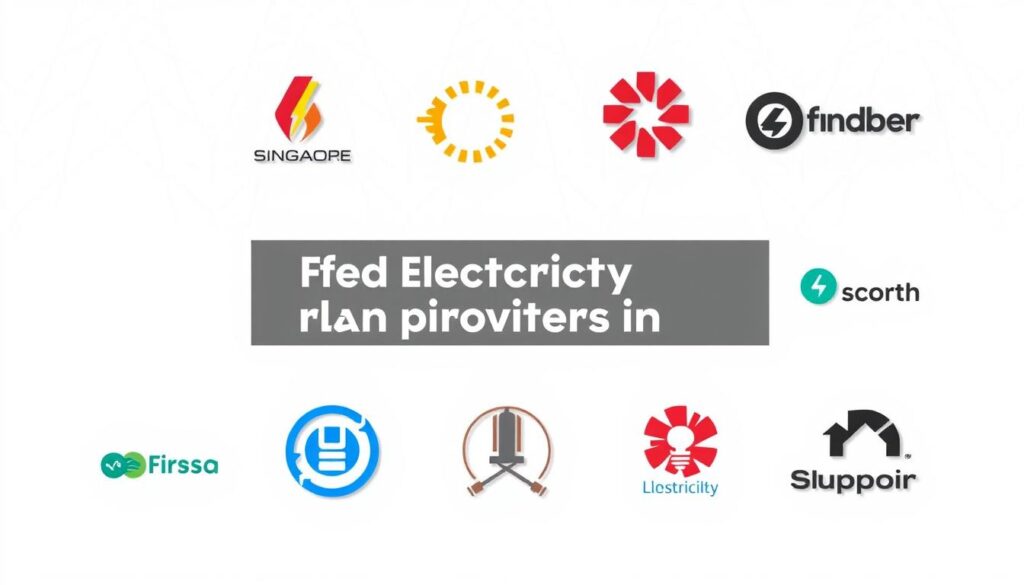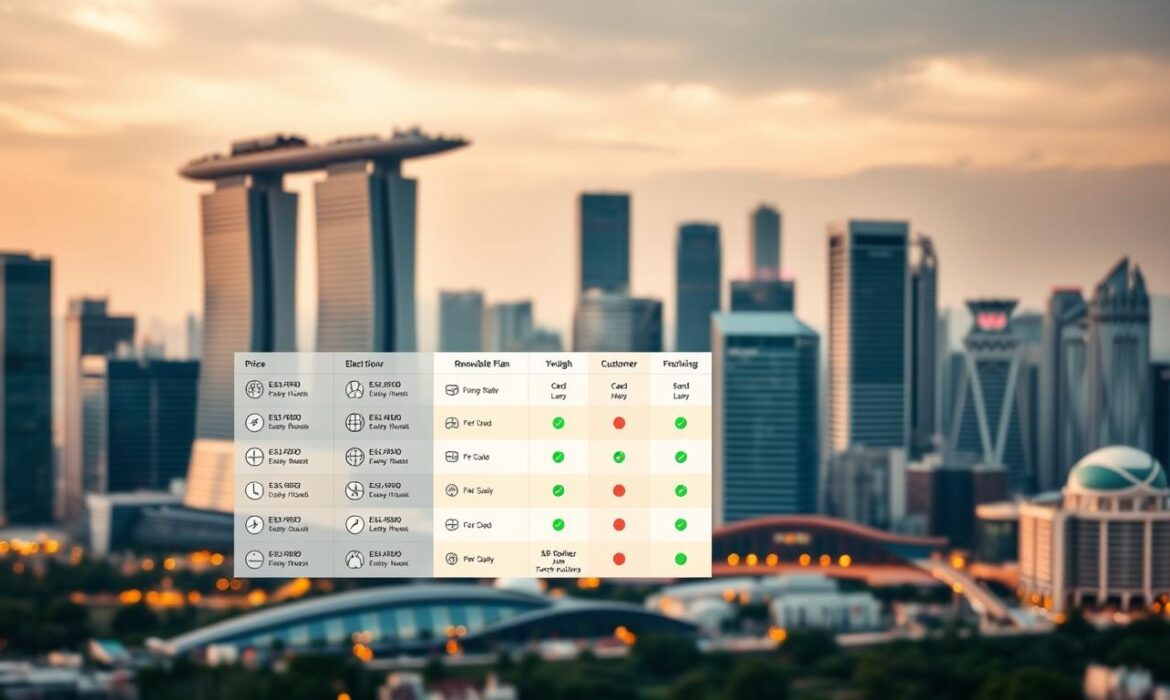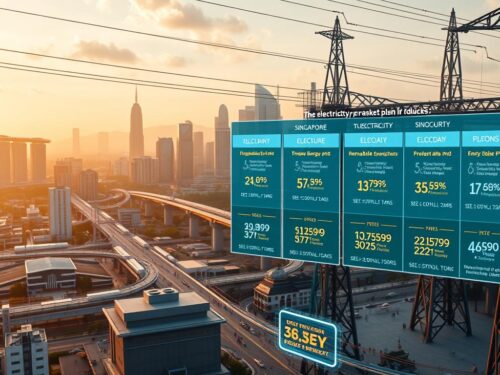Singapore’s energy market offers a variety of options for consumers. With multiple providers competing, there’s a chance to save significantly by choosing the right option. Understanding the differences between plans can help you make an informed decision.
Currently, the regulated tariff stands at 30.65¢/kWh for Q1 2025. This serves as a benchmark when comparing offers from retailers. Fixed and discount tariff plans are the most common, each with unique benefits.
For an average 4-room HDB household, switching providers could mean monthly savings of $6 to $15. Taking the time to compare options ensures you get the most value for your needs.
Key Takeaways
- Singapore’s energy market is competitive, offering savings opportunities.
- Compare plans from six major retailers to find the best fit.
- The Q1 2025 regulated tariff is 30.65¢/kWh.
- Fixed and discount tariff plans have key differences.
- Switching providers can save households $6-$15 monthly.
Introduction to the Open Electricity Market (OEM) in Singapore
Since its launch in 2019, the Open Electricity Market has reshaped Singapore’s energy landscape. This initiative by the Energy Market Authority (EMA) allows consumers to choose their preferred energy provider, fostering competition and offering more options for households. With six active retailers in the market, the OEM empowers consumers to find plans that suit their needs and budgets.
Before the OEM, SP Group was the sole provider, offering electricity at a regulated tariff. Now, consumers can compare pricing models from multiple retailers, often leading to immediate savings. For example, switching to an electricity retailer can save households up to 9% compared to the regulated tariff.
What is the Open Electricity Market?
The Open Electricity Market marks the final phase of market liberalization efforts in Singapore. It allows all consumers to choose who they wish to buy electricity from. Whether through a retailer, the wholesale market, or SP Group, the national power grid ensures uninterrupted supply. This flexibility gives households more control over their energy consumption and costs.
Benefits of Switching to an Electricity Retailer
Switching to an electricity retailer offers several advantages. First, consumers can enjoy competitive pricing, often lower than the regulated tariff. Second, the process is seamless, with no disruption to your energy supply. Finally, many retailers offer green energy plans, allowing households to reduce their carbon footprint. For more details, visit the Open Electricity Market overview.
With these benefits, it’s no wonder more households in Singapore are exploring their options in the electricity market. Whether you’re looking to save money or support sustainable energy, the OEM provides a platform to make informed choices.
Understanding Electricity Tariffs in Singapore
Electricity tariffs in Singapore are influenced by several key factors. These include energy costs, network expenses, and market operations. The Energy Market Authority (EMA) adjusts tariffs quarterly to reflect changes in these components. Understanding how tariffs work can help you manage your energy costs effectively.

How are electricity tariffs calculated?
Tariffs are calculated based on four main components:
- Energy Costs (21.36¢/kWh): Reflects the cost of generating power.
- Network Cost (6.46¢/kWh): Covers the maintenance of the power grid.
- Market Support Services (MSS) (0.23¢/kWh): Ensures market stability.
- Market Operations (0.07¢/kWh): Manages market transactions.
These components are added together to determine the base rate. A 9% GST is then applied to the final price.
Current electricity rates for Q1 2025
The regulated tariff for Q1 2025 is 30.65¢/kWh. This represents a 3.4% decrease from the previous quarter. For a 4-room flat using 365kWh monthly, the bill would be approximately $111.87. The Transmission Loss Factor (TLF) also affects billing, accounting for energy lost during transmission.
Historical trends show that tariffs fluctuate based on global energy prices and local market conditions. By understanding these factors, you can make informed decisions about your energy consumption. For more insights, visit our guide on finding the right plan.
Types of Electricity Price Plans Available
Consumers in Singapore have access to diverse energy pricing models. These price plans cater to different needs, whether you prefer stability or flexibility. Understanding the options can help you make an informed decision.
Fixed Price Plans
Fixed price plans offer stability by locking in a rate for the contract duration. This means your rate won’t change, even if the regulated tariff fluctuates. For example, Geneco’s Get It Fixed 24 offers a rate of 28.87¢/kWh, while PacificLight’s 36M plan is slightly lower at 28.44¢/kWh.
These plans are ideal for households that prefer predictable monthly bills. However, longer contracts may come with early termination fees, so choose wisely.
Discount Off Regulated Tariff (DORT) Plans
DORT plans provide a percentage discount off the regulated tariff. For instance, PacificLight’s 60-month plan offers a 3% discount plus a 5% bill rebate for prompt payment. This type of plan is beneficial when the regulated tariff decreases, as your savings increase.
However, if the tariff rises, your bill could also go up. DORT plans are best for those comfortable with some variability in their monthly costs.
Other options include green energy plans, like Sembcorp’s Sunshine Plan at 42.31¢/kWh, and time-of-use plans, such as PacificLight’s off-peak rates from 9pm to 9am. These cater to eco-conscious consumers and those with flexible energy usage patterns.
Top Electricity Providers in Singapore
With multiple retailers in the market, consumers have a wide range of options to choose from. Each provider offers unique features and benefits, making it essential to compare their offerings. Below, we’ve highlighted the key details of the top providers to help you make an informed decision.

Geneco
Geneco stands out for its market leadership and flexible contract options. Their 24-month plan costs $105.38 per month for a 4-room household, providing stability and predictability. They also offer green energy options for eco-conscious consumers.
Keppel Electric
Keppel Electric is known for its attractive promotions, including UOB card discounts and exclusive BTO package deals. These offers make it a popular choice for new homeowners looking to save on their energy bills.
PacificLight
PacificLight offers the Savvy Saver series, which includes KrisFlyer miles rewards for frequent travelers. Their plans are designed to cater to diverse needs, ensuring flexibility and value for money.
Sembcorp Power
Sembcorp Power provides bundled offers, such as MyRepublic broadband packages, making it a convenient choice for households seeking multiple services. Their Sunshine Plan supports green energy initiatives.
Senoko Energy
Senoko Energy offers appliance rebates for Giro users, adding extra value to their plans. This makes it an excellent option for those looking to maximize savings on both energy and household appliances.
Tuas Power
Tuas Power features an 18-month plan at 29.63¢/kWh, providing competitive rates for mid-term commitments. Their straightforward pricing and reliable service make them a trusted choice.
| Provider | Key Features | Monthly Cost (4-room) |
|---|---|---|
| Geneco | Flexible contracts, green energy options | $105.38 |
| Keppel Electric | UOB card promotions, BTO package deals | Varies |
| PacificLight | Savvy Saver series, KrisFlyer miles rewards | Varies |
| Sembcorp Power | Bundled MyRepublic broadband offers | Varies |
| Senoko Energy | Appliance rebates for Giro users | Varies |
| Tuas Power | 18-month plan at 29.63¢/kWh | Varies |
Comparing the Best Electricity Plans in Singapore
Finding the right energy option can be a game-changer for your monthly budget. With a variety of fixed-rate and discount-regulated plans available, it’s essential to understand the details to maximize savings. Let’s break down the key options to help you make an informed choice.

Cheapest Fixed Price Plans
Fixed-rate plans offer stability by locking in a rate for the contract duration. For example, Geneco and Senoko’s 12-month plans start at 28.87¢/kWh. These are ideal for households that prefer predictable monthly bills.
However, it’s important to note that longer contracts may come with early termination fees. Always review the terms before committing to ensure it aligns with your needs.
Best Discount Off Regulated Tariff Plans
Discount-regulated plans, like PacificLight’s 3% discount plus stacking rebates, can offer significant savings. These plans adjust based on the regulated tariff, making them a flexible option for those comfortable with some variability.
For instance, PacificLight’s Easy Peasy plan charges 27.80¢/kWh plus a daily fee. While the rate is competitive, be mindful of hidden costs like daily charges when comparing options.
“Understanding your energy consumption is key to choosing the right plan. High users may benefit from fixed rates, while low users might prefer discount-regulated options.”
Hidden Costs and Recommendations
When comparing plans, look beyond the base rate. Daily charges, transmission fees, and other hidden costs can impact your total bill. For high-energy users, fixed-rate plans often provide better value. Low users, on the other hand, might save more with discount-regulated options.
Credit Card Synergies
Maximize your savings by leveraging credit card rebates. For example, Maybank and NTUC Link offer additional discounts when used for bill payments. These synergies can further reduce your monthly expenses.
| Plan Type | Provider | Rate (¢/kWh) | Key Features |
|---|---|---|---|
| Fixed Rate | Geneco | 28.87 | 12-month contract, stable pricing |
| Fixed Rate | Senoko | 28.87 | 12-month contract, no hidden fees |
| Discount Regulated | PacificLight | 27.80 + daily charge | 3% discount, stacking rebates |
How to Choose the Best Electricity Plan for Your Needs
Selecting the right energy option requires careful consideration of your household’s needs and usage patterns. Whether you’re in a 4-room HDB flat or a landed property, understanding your consumption habits is key to finding a suitable plan.

Factors to Consider When Selecting a Plan
Start by evaluating your household’s energy usage. For example, a 4-room flat typically consumes around 365kWh monthly, while a bungalow may use up to 2,190kWh. Conduct an appliance audit to identify high-energy devices like air conditioners and water heaters.
Next, weigh the pros and cons of contract flexibility versus rate security. Fixed-rate plans offer stability, while discount-regulated options can save you money when tariffs drop. Consider green energy premiums if sustainability is a priority.
Understanding Your Electricity Consumption
Your energy needs depend on factors like property type and lifestyle. HDB flats often have lower consumption compared to landed homes. Additionally, SP Wholesale Plans come with risks due to price volatility, ranging from $0.069 to $4.42 per kWh.
By analyzing your usage and comparing plans, you can make an informed decision that aligns with your budget and preferences. This ensures you get the most value for your household’s needs.
Promotions and Rebates from Electricity Retailers
Retailers in Singapore are offering exciting promotions to attract new customers. From bill rebates to appliance bonuses, these deals can significantly reduce your monthly expenses. Understanding the latest offers and how to maximize them is key to getting the most value.
Current Promotions and Discounts
Many providers are rolling out limited-time deals. For example, Senoko is offering a Philips air fryer for customers who make three payments with a Trust card. Geneco’s $888 referral contest rewards top referrers with substantial bill rebates.
PacificLight provides a 5% discount for prompt payments, while Keppel Electric offers up to $180 in rebates for UOB cardholders. These promotions make it easier to save while enjoying reliable service.
How to Maximize Savings with Rebates
Stacking strategies can amplify your savings. Combine referral codes, credit card promotions, and Giro payments to unlock multiple discounts. For instance, PacificLight offers up to $188 in rebates when you refer friends and pay promptly.
Appliance bonuses, like Dreame hair dryers and Xiaomi vacuums, add extra value. Some providers even waive security deposits for preferred payment methods. By leveraging these offers, you can significantly reduce your energy costs.
“Stacking promotions and rebates is a smart way to maximize savings. Always check for hidden terms to ensure you’re getting the best deal.”
For a detailed comparison of current offers, visit our electricity retailer comparison guide. This resource helps you identify the most cost-effective options for your household.
Switching to an Electricity Retailer: A Step-by-Step Guide
Making the switch to a new energy provider can seem daunting, but it’s simpler than you think. Whether you’re looking for better rates or greener options, the process is designed to be smooth and hassle-free. Here’s everything you need to know to make the transition seamless.
How to Switch from SP Group to an OEM Retailer
Switching to an electricity retailer starts with choosing a provider that fits your needs. Once you’ve selected a plan, you’ll need to provide some basic documentation, including your NRIC and SP account number. Most retailers allow you to complete the process online, making it quick and convenient.
After submitting your application, there’s typically a one-week lead time for meter appointments. During this period, your energy supply remains uninterrupted. Once the switch is complete, you’ll receive a pro-rated bill from SP Group for the transition period.
What to Expect During the Switching Process
One of the key things to prepare for is setting up a set recurring bill arrangement. Many retailers, like Keppel Electric, require Giro payments to unlock specific promotions. This ensures your payments are timely and hassle-free.
It’s also important to be aware of early termination fees, which can range from $0 to $200 depending on your contract. Unlike some services, there’s no cooling-off period, so make sure you’re fully committed before making the switch.
“Switching providers is a great way to save money and explore greener energy options. Just ensure you’ve reviewed all terms and conditions to avoid surprises.”
By following these steps, you can confidently transition to a new provider and start enjoying the benefits of a competitive energy market. Ready to make the switch? Start comparing plans today!
Understanding Your Electricity Bill
Understanding your monthly energy statement can help you manage costs effectively. A typical bill includes several components, such as usage charges, transmission fees, and taxes. For a 4-room HDB flat, the average cost is $111.87, but switching to an OEM retailer can reduce this to $105.38.
Breaking Down Your Electricity Bill
Your bill is more than just a total amount. It includes line items like TLF adjustments, which account for energy lost during transmission, and carbon taxes. Tracking peak and off-peak usage can also help you identify patterns in your electricity consumption.
SP Services and OEM retailers may have different billing interfaces. While SP provides a straightforward breakdown, some retailers offer detailed tracking tools to monitor your usage in real-time. This can be especially useful for households looking to optimize their energy habits.
Tips to Reduce Your Monthly Electricity Costs
There are several ways to lower your monthly expenses. Start by retrofitting your home with LED lights, which use less energy than traditional bulbs. Inverter air conditioners are another great option, as they adjust cooling based on room temperature, reducing overall kWh usage.
Take advantage of U-Save GST vouchers, which can offset part of your energy costs. Additionally, many retailers offer rebates for using Giro payments or credit cards. These small changes can add up to significant savings over time.
Conclusion: Finding the Best Electricity Plan Singapore
Choosing the right energy provider can lead to significant savings and better service. When making your decision, consider factors like rate type and contract length. Fixed rates offer stability, while discount options can save you more when tariffs drop.
Don’t miss out on promo stacking opportunities. Combining referral codes, credit card rebates, and Giro payments can maximize your savings. Keep an eye on the market, especially during renewal periods, to ensure you’re always getting the best deal.
Comparing OEM providers to the SP regulated tariff shows clear cost advantages. Switching can reduce your monthly expenses while offering more flexibility. Ready to find the right fit? Get personalized recommendations today and start saving.



